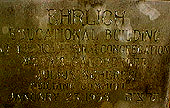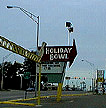Following brief remarks regarding the synagogue building the
story of Texarkana will be largely told through the words of Melvin
Kusin and his son Michael, recorded during a driving tour of the
city 10 July 1996. Select a sound file (50-150k) link (*) and
"save link as source" to your computer, then play via
RealAudio Player.
This modernist confection, built in 1948, was a model for at least one other synagogue. A committee from Port Arthur made several trips to study it before building a near replica a few years later. The articulation of parts in a fairly obvious and diagrammatic way is clearly different from the pre-war models such as San Angelo or Baytown.
The Jewish community in Texarkana was already well-established by the last quarter of the 19th century. A wooden synagogue was built early in this century and a more substantial social hall somewhat later. Except for the cornerstones embedded in the new building no trace remains of the earlier structures which were demolished in the early '50's.


This line drawing of the Ehrlich social hall appeared in the
50th Anniversary Ad Book in 1935 along with the history, a list
of notable members, and a celebratory program featuring Yetta
Wexler, pianist.
With apologies to the subject for poor graphic reproduction, Miss Wexler was a prodigy from a family of prodigies. The Wexler's* had come from Russia a few years before and despite hardships and obstacles encountered by any greenhorn quickly demonstrated in their several ways outstanding ability and talent. Max Wexler, Yetta's brother, remained in Texarkana, achieved business and civic prominence, and was a leader of the Jewish community for many years.
The area around Central School* was an
incubator for Jewish absorption. Most eventually operated small
stores* along Broad St. The Feinberg
family operated the Savoy* Hotel. Although
a few attained "membership" in local cafe society, most
Jews regardless of economic status kept a low
profile*. Although there was almost no overt anti-Semitism,
the country club* remained off-limits to
Jews till fairly recently.
After the ignominious economic collapse*
of Jefferson, the reform Germans
who founded the Jewish community there, dispersed to surrounding
towns in Northeast Texas. Texarkana, however, was made up largely
of Russian* and Polish Jews with a few
notable exceptions such as Judge Louis Joseph*.
Despite the majority's Orthodox antecedents religious observance
tended, as in most small towns in the South, toward Reform. When
there were exceptions*, they were accommodated
gracefully. Leo Walkow*, like his brothers
in Seattle and Houston, did much to bring traditional Judaism
to Texarkana and strongly influenced the generation educated in
the late '50's. The Jewish community from the very beginning set
an example of tzedakah*, charitable
giving, which spread to the entire town.


Now the Grim Hotel, once a favored spot for local simchas, is boarded up, and the Holiday Bowl provides almost the only live entertainment on State Line Avenue these days.
